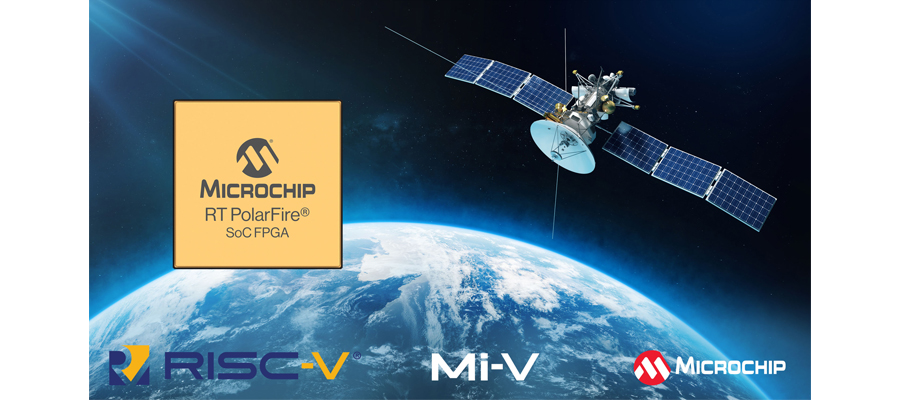Along with Microchip’s Mi-V ecosystem, new device family helps system designers to lower power, size and weight and speed time to market
Developers of spacecraft electronics utilize radiation-tolerant (RT) field programmable gate arrays (FPGAs) to ensure high performance, reliability, power-efficiency and the best-in-class security for emerging space domain threats. To take it a step further and help provide fast, cost-effective software customization, Microchip Technology (Nasdaq: MCHP) has introduced the RT PolarFire® system-on-chip (SoC) FPGA. Developed on Microchip’s RT PolarFire FPGA, it is the first real-time Linux® capable, RISC-V-based microprocessor subsystem on a flight-proven RT PolarFire FPGA fabric.
With today’s announcement, developers can now start designing using the commercially available PolarFire SoC (MPFS460) device and Libero® SoC development tools. Along with Microchip’s extensive Mi-V ecosystem, PolarFire SoC solution stacks, the PolarFire SoC Icicle Kit or the PolarFire SoC Smart Embedded Vision Kit, developing lower power solutions for the challenging thermal environments seen in space can happen today.
Safety-critical systems, control systems, space and security applications need the flexibility of the Linux Operating System (OS) and the determinism of real-time systems to control hardware. RT PolarFire SoC FPGAs feature a multi-core Linux-capable processor that is coherent with the memory subsystem. The RT PolarFire SoC enables central satellite processing capabilities similar to those in single board computers which are common in the space industry for command and data handling, in platform avionics and in payload control. The SoC allows for flexible implementation of highly integrated designs, customization and evolution of function while improving size, weight and power considerations.
Systems deployed in space are subjected to harsh radiation, prompting design methodologies that can provide protection for the most critical radiation-induced upset types. Unlike SRAM FPGAs, the RT PolarFire SoC is designed for zero configuration memory upsets in radiation, eliminating the need for an external scrubber and reducing the total system cost. Satellites are designed to deliver both peak and average power and to dissipate heat through conductive paths, namely metal. Starting with a SoC FPGA that can reduce your power consumption by up to 50 percent simplifies the entire satellite design, allowing designers to focus on the mission at hand.
“By delivering the design ecosystem for the industry’s first RISC-V-based radiation-tolerant SoC FPGA, Microchip is driving innovation and giving designers the ability to develop a whole new class of power-efficient applications for space.” said Bruce Weyer, corporate vice president for Microchip’s FPGA business unit. “This will also allow our clients to add enhanced edge compute capabilities to aerospace and defense systems.”
Microchip’s comprehensive Mi-V ecosystem helps designers slash time to market by providing support for symmetric multiprocessing (SMP) rich operating systems like Linux, VxWorks®, PIKE OS and more real time operating systems like RTEMS and Zephyr®. Mi-V is a comprehensive suite of tools and design resources, developed with numerous third parties, to support RISC-V designs. The Mi-V ecosystem aims to increase adoption of the RISC-V instruction set architecture (ISA) and support Microchip’s SoC FPGA portfolio.
The RT PolarFire FPGA has already received the Qualified Manufacturers List (QML) Class Q designation based on specific performance and quality requirements as governed by the Defense Logistics Agency. There is also a clear path for this device to achieve QML Class V qualification, the highest qualification standard for space microelectronics.
For more than 60 years, Microchip’s solutions have powered space flight missions. Building on a history of providing reliable, low-power SONOS-, Flash- and antifuse-based FPGAs in the industry, the company works to help streamline the design of high-speed communications payloads, high-resolution sensors and instruments and flight-critical systems for Low Earth Orbit (LEO), deep space or anything in between. To learn more, visit Microchip’s radiation-tolerant FPGA page.
Availability of Development Tools
Customers can start designs now with the development tools and boards provided for the commercial equivalent PolarFire SoC. For more information, visit the PolarFire SoC page.
Resources
High-res images available through Flickr or editorial contact (feel free to publish):
- Application image:
https://www.flickr.com/photos/microchiptechnology/53640600685/sizes/l/






